Achillea spp.
Yarrow, Achillea spp., is a semi-evergreen flowering perennial in the aster, or Asteraceae family.
Suitable for growers in USDA Hardiness Zones 3 to 9, it has corymb, or flattened, flower heads with densely clustered blossoms in shades of pink, red, white, and yellow.
In this article, you’ll learn all you need to know to cultivate and maintain yarrow in your garden.

We link to vendors to help you find relevant products. If you buy from one of our links, we may earn a commission.
Here are the topics we’ll explore:
What You’ll Learn
I enjoy growing yarrow in my garden because it offers rich color in return for minimal water and maintenance. I can’t wait to tell you all about it!
Cultivation and History
In ancient Europe and Asia, Achillea was a mainstay of artistic, cosmetic, culinary, medicinal, and even magical applications around the world.
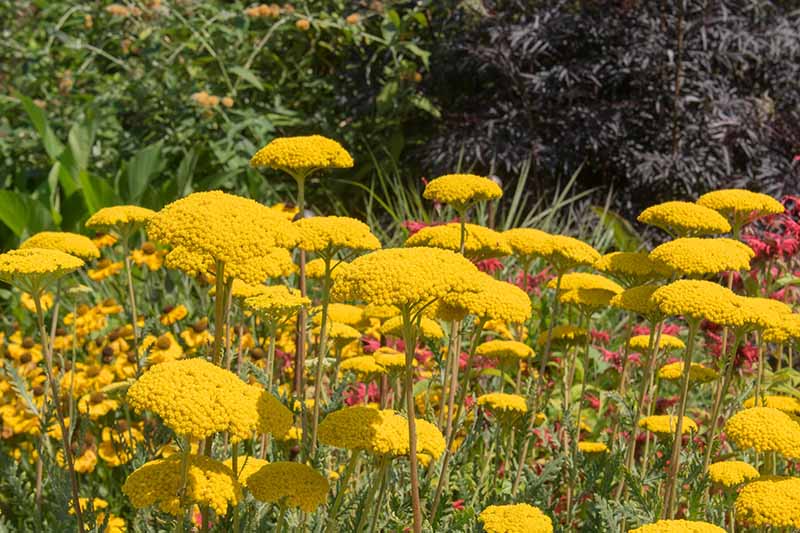
Legend has it that Achilles of Troy used it to treat his wounded soldiers.
There is even evidence to support its use in burial rituals as far back as the time of the Neanderthals, with fossilized pollen found at the Shanidar burial site in Iraq.
Fast forward to the US today, where common yarrow, A. millefolium, as well as modern cultivars and hybrids, are still used in cooking, fresh and dry floral design, and herbal remedies.
There are nearly 100 species in the genus Achillea. They are best suited to USDA Hardiness Zones 3 to 9, although you may have success growing them as far north as Zone 2, and as far south as Zone 10.
According to Wanda MacLachlan et al, at the Cooperative Extension Service of the University of Maryland, A. clypeolata, A. filipendulina, A. millefolium, A. ptarmica, and A. taygetea have been hybridized to create the majority of today’s cultivars.
They are especially prized by the cut flower industry for their large blooms, sturdy stems, and wide array of colors.
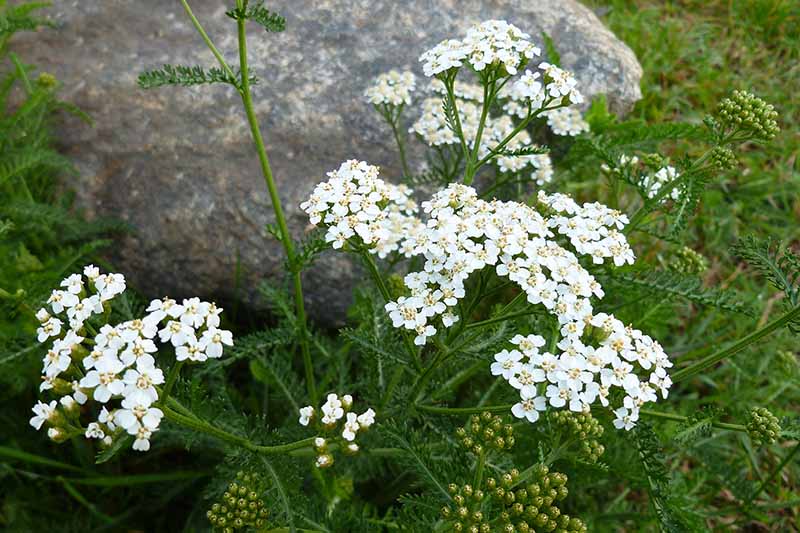
For the home garden, you are most likely to find cultivars of A. millefolium and A. filipendulina.
A. millefolium, common yarrow, aka milfoil, is a species with two- to three-inch white flower heads, and mature heights of up to three feet.
It spreads so vigorously that it may become invasive in some regions. Contact your local agricultural extension before planting it, to determine its likely behavior in your area.
You can learn more about the benefits and uses of yarrow in this article.
A. filipendulina, aka fern leaf yarrow, is also commonly called milfoil. The botanical species, as found in the wild, has four-inch mustard yellow flower heads.
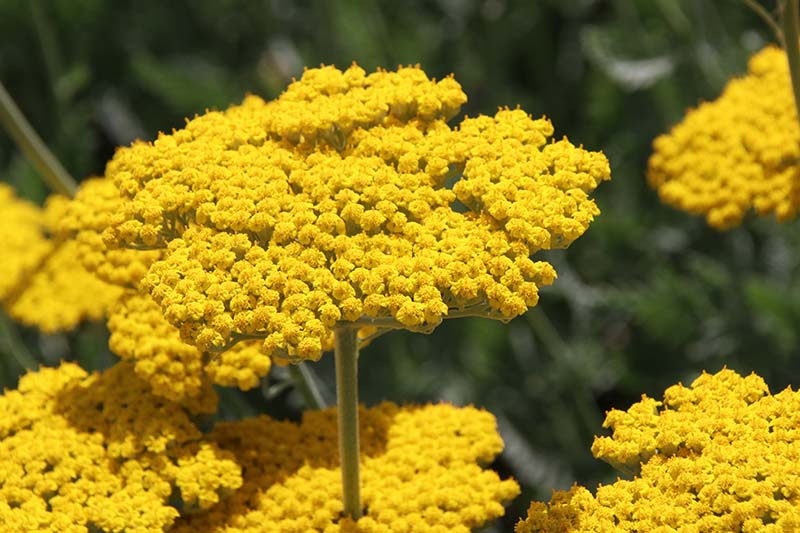
Cultivars are yellow of varying hues, with flowers of up to six inches across, and heights of up to four feet.
The erect stems of the various Achillea species are noteworthy for being stiff and strong. The foliage is soft, and ranges from medium green to silver-green, with light fuzz. It is deeply serrated and feathery.
A Note of Caution:
Please note that Achillea may cause allergic reactions in people with sensitivity to members of the Asteraceae family of plants. In addition, it is toxic to cats, dogs, and horses.
Yarrow Plant Propagation
To grow this colorful perennial, you can sow seeds, divide existing plants, or take tip cuttings.
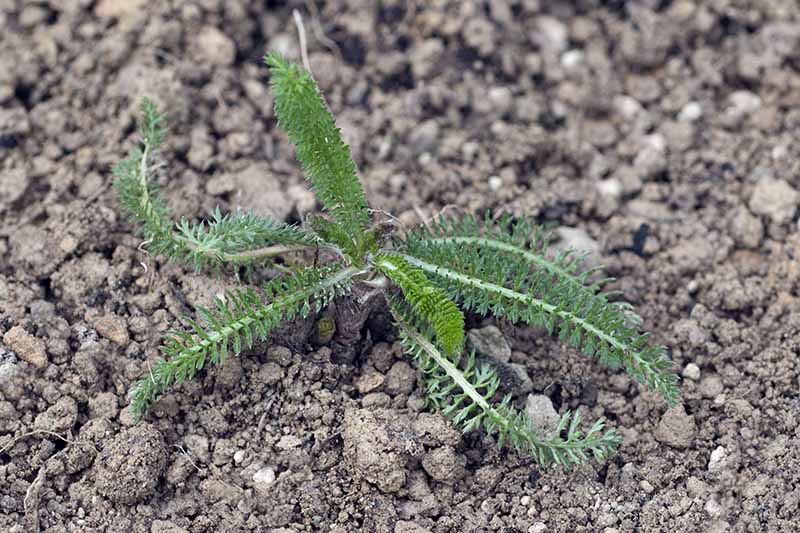
The experts at the University of Maryland’s Cooperative Extension Service offer excellent growing guidance.
Let’s consider the three methods per their recommendations.
From Seed
For flowers in the first year, you can start seed indoors or in a greenhouse in February or March. Sow in seed trays with a well-draining potting soil.
Germination takes one to two weeks. Ideal conditions include a temperature of 65 to 70°F and 90 percent humidity.
Once sprouted, the temperature may be reduced to 55 to 60°F.
You can thin the seedlings and transplant the sturdiest plants to individual pots at this time, and fertilize with a high nitrogen fertilizer according to the package instructions.
Alternatively, you may direct sow seeds in the garden at a depth of half an inch, after the last average frost date for your region has passed.
Apply high nitrogen fertilizer once, just after the seeds sprout. Expect flowers in the second year.
By Division
You can make new plants by dividing mature ones in early spring. The advantage of this method is that divisions will replicate the exact traits of the parent plant.
Choose a section of plant with two or three stems and cut straight down through the thick rhizomes to separate it from the main clump, for immediate planting elsewhere.
For more information about how to do this, check out our guide to dividing perennials.
From Tip Cuttings
To propagate cuttings, take a sharp knife and cleanly cut a stem of soft spring growth off at the third or fourth leaf node down from the top, about six inches long.
Remove the lower two leaves to reveal a bare stem.
Place the stem into potting medium, such as a mixture of vermiculite or perlite and peat moss.
Place in a greenhouse or other sunny location with low humidity and temperatures of approximately 50 to 60°F.
Once new growth is evident, plants have rooted and are ready for transplanting to the garden.
How to Grow Yarrow
Yarrow is a hardy, cold- and drought-tolerant perennial that blooms from June to September. Its stiff, flattened flower heads are made up of multiple tiny blossoms, some with contrasting centers.
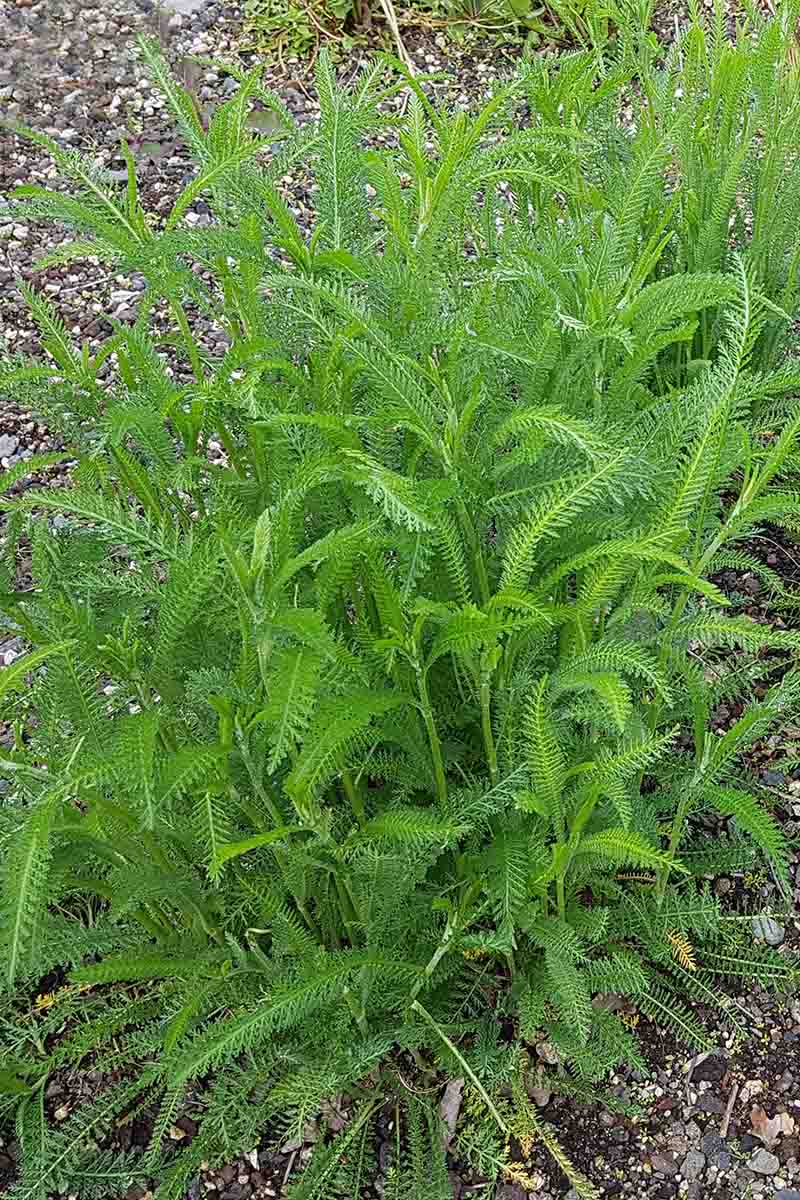
To cultivate it, choose a full sun location.
The ideal soil is sandy, and of average to poor quality. This is one plant that does not have a preference for organically-rich loam.
It can grow in fertile soil, but will likely grow too fast and become “leggy,” and this can result in the stems flopping under the weight of heavy blooms.
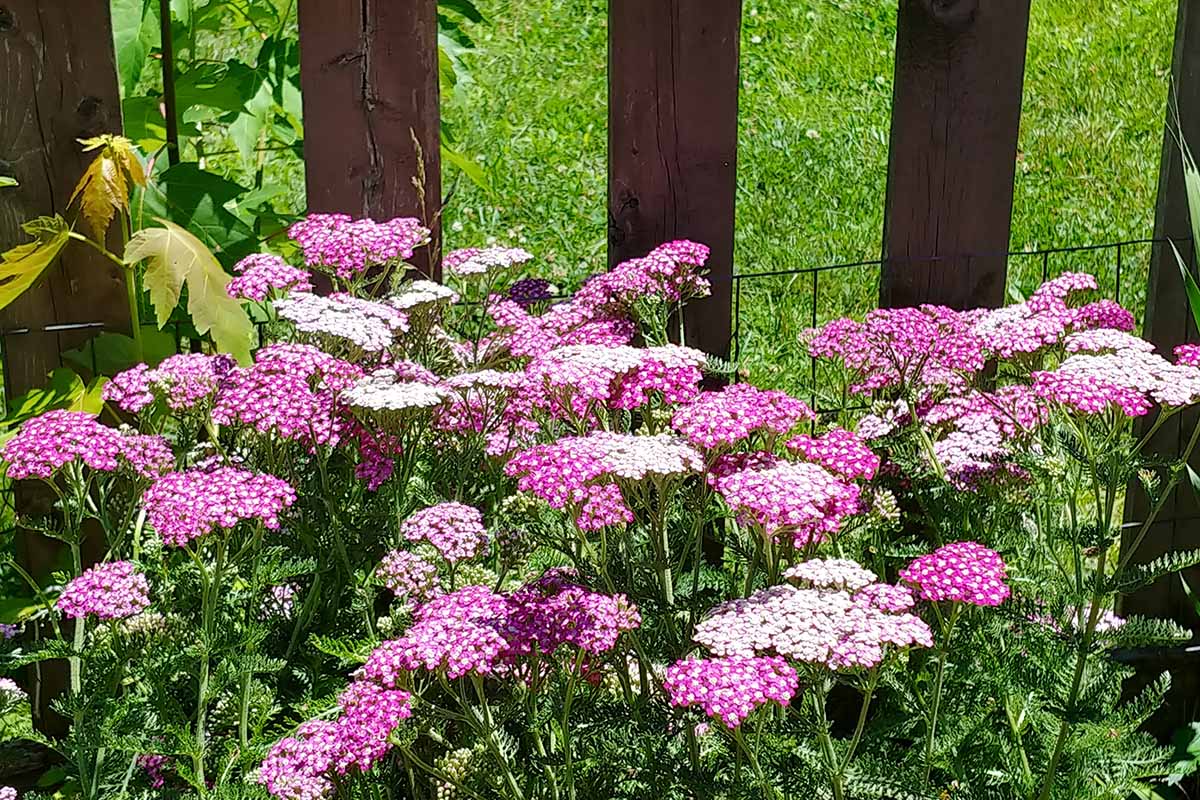
The soil pH should be between 4.0 and 8.0. A measurement of 6.4 is considered optimal. To determine your soil’s pH, conduct a soil test through your local agricultural extension office.
The soil quality may be somewhat poor, but the drainage must be excellent. Yarrow is not a plant that puts up with wet feet, nor does it appreciate humid conditions.
Achillea thrives best in dry heat. However, there are cultivated hybrid series such as Galaxy and Seduction that tolerate some humidity.
Plants average two to four feet tall at maturity, although some botanical species (as found in the wild) may be shorter, and there are hybrids that may top out at a towering five feet.
Widths range from one to three feet.
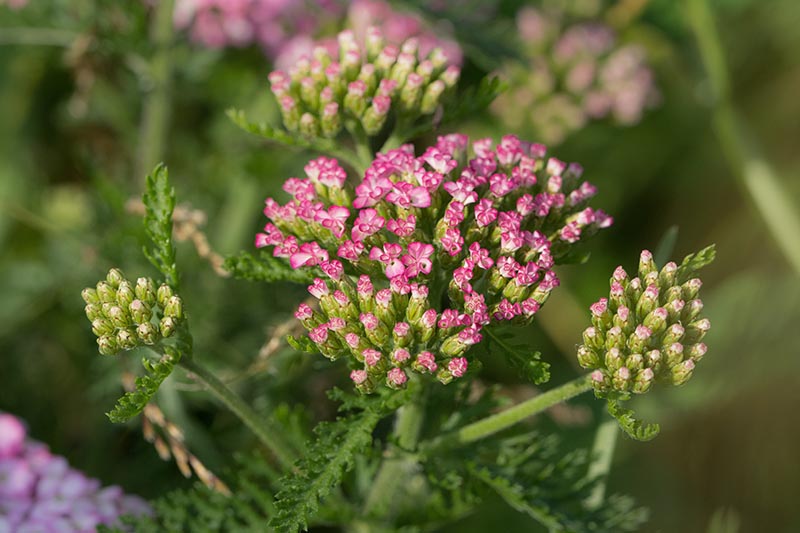
Be sure to account for mature dimensions when choosing your planting location. Achillea species are vigorous growers, and reach mature dimensions in the second year of growth.
Whether you start with seeds, divisions, or tip cuttings, new plants require about an inch of water per week to help them to establish strong, deep roots. If it rains an inch, you can skip the additional irrigation.
Once established, yarrow is a water-wise, drought-resistant powerhouse. However, if a dry spell is prolonged, please water it rather than test its tolerance.
Growing Tips
Once established, a sturdy plant like yarrow works hard in the garden, especially when you remember these three tips for success:
- Choose humidity-tolerant cultivars if needed.
- Poor soil is better than rich to promote compact plants that grow at a moderate rate.
- Drought tolerance doesn’t mean you should never water.
Give your plants a good start and they’ll reward you with years of color, in exchange for a little upkeep. Let’s find out just how little is required.
Pruning and Maintenance
If you establish your plants with care, and it rains every once in a while, you may be able to get through an entire summer without providing supplemental water.
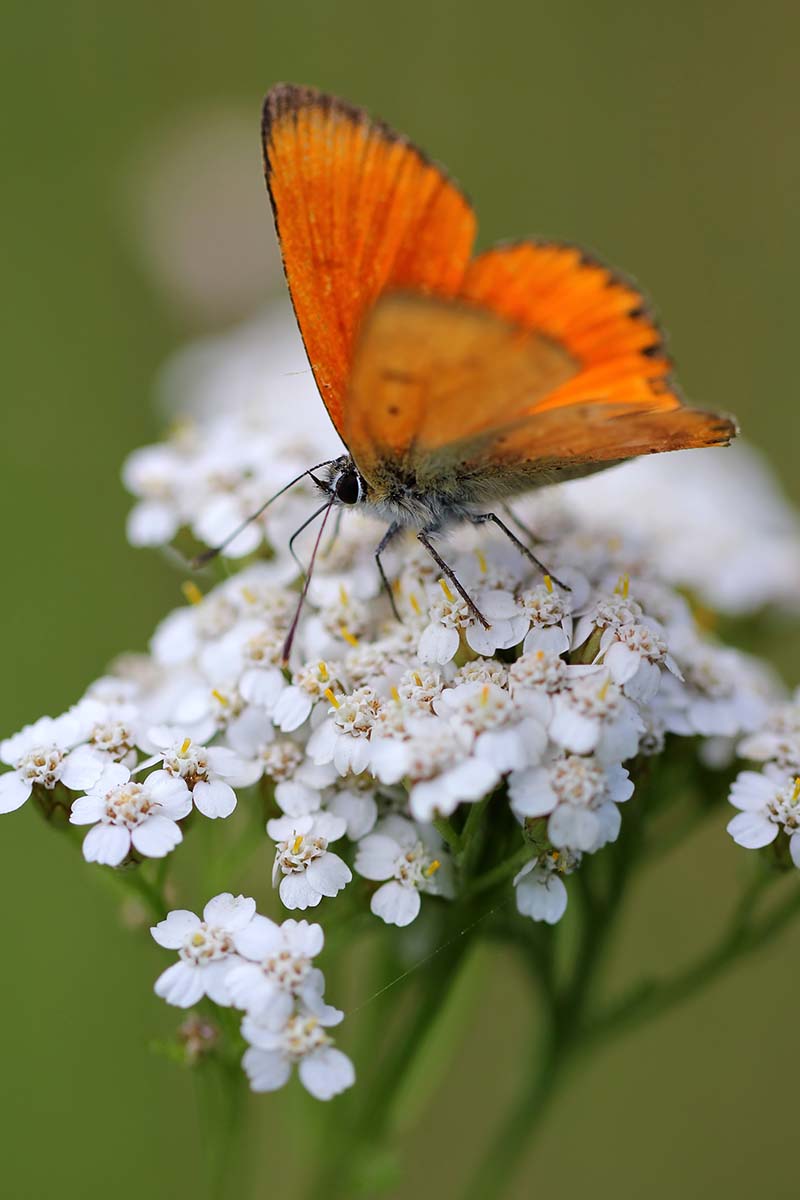
However, in the prolonged absence of rain, you may want to drag the hose out, especially with first-year plants.
When you grow Achillea, you’ll become familiar with its habits. There are generally two main flushes of bloom; one is in spring, and the other is later in the summer.
You may prune plants deeply, by about one-half after the first flush of flowers, to keep the overall shape compact and encourage further blooming.
You may also deadhead or remove each spent flower stalk as it finishes, to prevent self-sowing, encourage more blooms, and keep plants tidy.
In addition, at season’s end, you can leave the dead flower stalks attached and let them drop their seed, cut them for dried arrangements, or prune them to the ground.
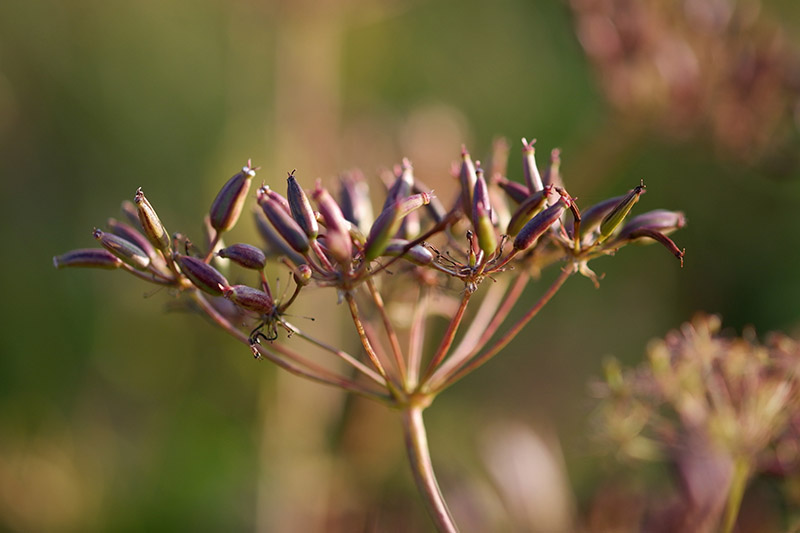
I like to deadhead during the summer, and leave the last blooms on for winter interest and wildlife habitat. Plants will die back and go dormant over the winter months.
If you choose to leave the stalks attached, you may rake everything up in late winter or early spring, before the new shoots appear.
Please note: seed dropped by yarrow may or may not replicate the traits of the parent plant from which it fell. Only true botanical species produce true seeds. Hybrids of two or more species may produce plants with characteristics of the various component species, but not of the hybrid they formed.
The yarrow you grow is likely to naturalize, forming an intricate system of rhizomes.
Every three years or so, it’s a good idea to divide your plants to rejuvenate them and increase airflow. You can plant the divisions elsewhere in the garden or give them to your friends.
The best time for dividing, or moving entire plants, is in late winter or early spring when new shoots first appear, but before the growing season is in full force.
Tall varieties and those planted in soil that’s too fertile may require staking to provide stability.
Yarrow Cultivars to Select
With a handle on the ins and outs of yarrow cultivation, it’s time to check out some of the vivid hues available.
If you would like to get started with a species plant, you can find A. millefolium which sports white flowers, available from Earthbeat Seeds in packets of 100.
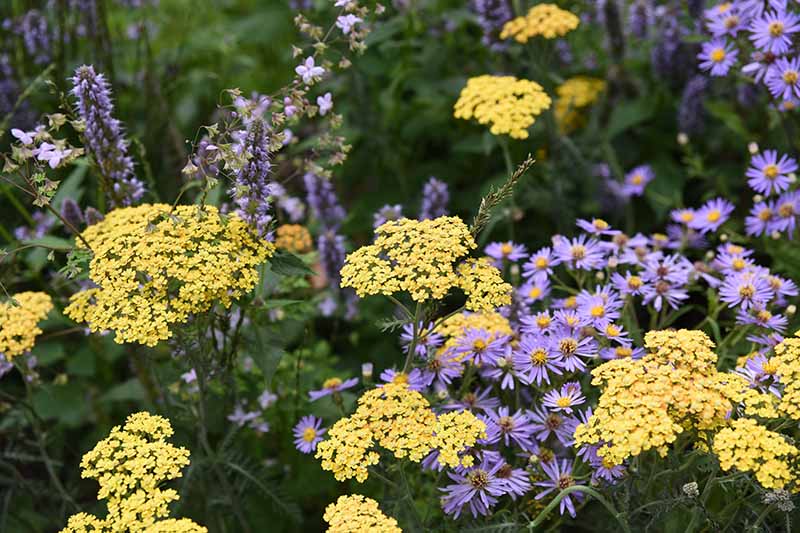
Below are three of my favorite cultivars, and you can learn more about the different varieties of yarrow here.
Cerise Queen
A. millefolium ‘Cerise Queen’ is a common yarrow cultivar. Flowers are deep pink with white centers. It is appreciated for retaining its rich color when others pale in summer heat.
Stems grow to a modest two feet tall, and form a compact plant with basal mounds of feathery medium-green foliage.
Find ‘Cerise Queen’ seeds now from Eden Brothers in one ounce or quarter-pound packages.
Gold Plate
A. filipendulina ‘Gold Plate’ is a fern leaf cultivar with the distinctive mustard-yellow flowers of the species.
However, this cultivar is an enhanced version of the wildflower and it boasts exceptionally large, six-inch flower heads.
Equally impressive are its four- to five-foot stems that rise from mounds of fern-like silvery green basal leaves.
Find seeds in a variety of packet sizes from True Leaf Market.
Paprika
A. millefolium ‘Paprika’ is a brick red cultivar of common yarrow with contrasting gold centers. It fades gracefully to shades of pink and cream in the summer garden.
This is a Galaxy Series selection that is suitable for more humid climates.
The flowers of this variety are medium-sized and measure two to three inches across.
Mounds of medium-green, feathery basal foliage surround stems that top out at two feet tall.
Find ‘Paprika’ plants now from Nature Hills Nursery in #1 containers.
Whatever colors and heights you choose, the smooth, velvety flower heads of yarrow are sure to stand out in the summer garden.
Managing Pests and Disease
Yarrow isn’t particularly susceptible to pest or disease issues.
Plants that are healthy are the least likely to have problems. Those that are stressed by less than optimal conditions may become vulnerable to infestation and infection.

If you’ve planted in soil that is fertile, with an excess of moisture or a lack of airflow, you are extending an open invitation to pests and disease.
Disease
Damage to leaves, stems, and roots may require removal of affected plants and a fallow period to inhibit the spread of infection, particularly when it is soil-borne.
Fungal conditions may respond to treatment with fungicides.
If your plants show signs of deformity, discoloration, stunting, or wilting, contact your local agricultural extension to discuss specifics and make an assessment.
Diseases to be aware of include:
Botrytis Blight
Also known as gray mold, botrytis blight is a fungal infection caused by various species in the Botrytis genus.
Symptoms include brown, dead areas on the stems, flowers, and foliage. It’s most likely to occur in damp conditions.
Leaf Spot
Another fungal infection, leaf spot results in brown spots appearing on the foliage and is caused by a number of different species in the Septoria or Alternaria genera.
Damp conditions and lack of airflow between plants contribute to this condition.
Powdery Mildew
A common fungal infection, powdery mildew appears as a white powdery substance on the foliage of your plants. Treat with neem oil, or in the case of bad infections, try a fungicide.
Read more about treating powdery mildew here.
Root Rot
Caused by soil-borne fungi Rhizoctonia solani or Pythium spp., root rot does not respond well to fungicide treatments.
Plants will fail to thrive, and roots and stems appear black or brown. Remove and dispose of infected plants.
Rust
Rust colored spores on stems and leaves appear, caused by the fungus Puccinia cnini-oleracei.
Surrounding tissue can turn brown, and in the case of a bad infection, growth can be stunted.
Best Uses for Yarrow Plants
You can’t ask for a more cooperative garden flower than yarrow. Once established, it requires little water and asks only that you deadhead regularly to promote prolific blooming.
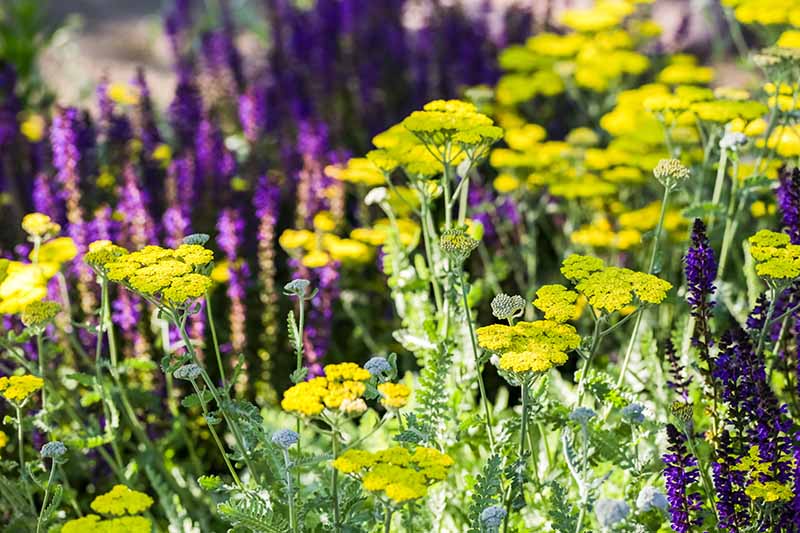
An attractive and reliable choice for beds, butterfly gardens, containers, and mixed borders, Achillea species and cultivars earn their keep in important ways.
They not only deter insect pests like mosquitoes and ticks, they attract beneficial pollinators including bees and butterflies, as well as birds that feed on pests like aphids.
They also repel herbivores like deer and rabbits with their pungent odor and taste.
In addition, their root systems run deep and pull up essential nutrients like calcium, copper, magnesium, phosphorus, and potassium that are advantageous to neighboring plants, like herbs and vegetables.

Use low growing varieties of yarrow in place of grass as a ground cover, or grow it in sunny meadows.
Add it to low-water, low-maintenance xeriscapes, where it plays well with other sandy-soil lovers like bee balm, calamint, catmint, coneflower, eryngium, globe amaranth, lavender, sage, salvia, and small globe thistle.
For seashore gardening, it can’t be beat for salt and wind tolerance.
And if you love to bring flowers inside like I do, you’ll appreciate the sturdiness of both fresh and dry yarrow stems and flower heads in vase arrangements.
Quick Reference Growing Guide
| Plant Type: | Herbaceous perennial herb | Flower / Foliage Color: | Pink, red, white, yellow; mid-green, silver-green |
| Native to: | Asia, Europe, North America | Water Needs: | Low |
| Hardiness (USDA Zone): | 3-9 | Maintenance: | Low |
| Season: | Late spring, summer | Soil Type: | Sandy, average to poor |
| Exposure: | Full sun | Soil pH: | 4.0-8.0; 6.4 best |
| Growth Rate: | Moderate to fast | Soil Drainage: | Well-draining |
| Spacing: | 1-3 feet | Companion Planting: | Bee balm, calamint, catmint, coneflower, eryngium, globe amaranth, herbs, lavender, sage, salvia, small globe thistle, vegetables |
| Planting Depth: | 1/2 inch (seeds) | Attracts: | Beneficial pollinators, birds |
| Height: | 2-4 feet | Uses: | Beds, butterfly gardens, containers, cut and dried, ground covers, meadows, mixed borders, shoreline gardens, xeriscapes |
| Spread: | 1-3 feet | Family: | Asteraceae |
| Tolerance: | Cold, drought, heat, poor soil, salt, wind | Genus: | Achillea |
| Pests & Diseases: | Aphids, mealybugs, spittlebugs; Botrytis blight, leaf spot, parasitic nematodes, powdery mildew, root rot, rust, stem rot | Species: | Various |
It Doesn’t Get Any Easier
I know you have a spot in the yard with poor soil and lots of sun, where you haven’t been able to get much of anything to grow. We all do.
Give yarrow a try. When it likes a location, it digs in and gets better each year. You’re going to love the colors and the way the flat tops look like velvet tapestry.
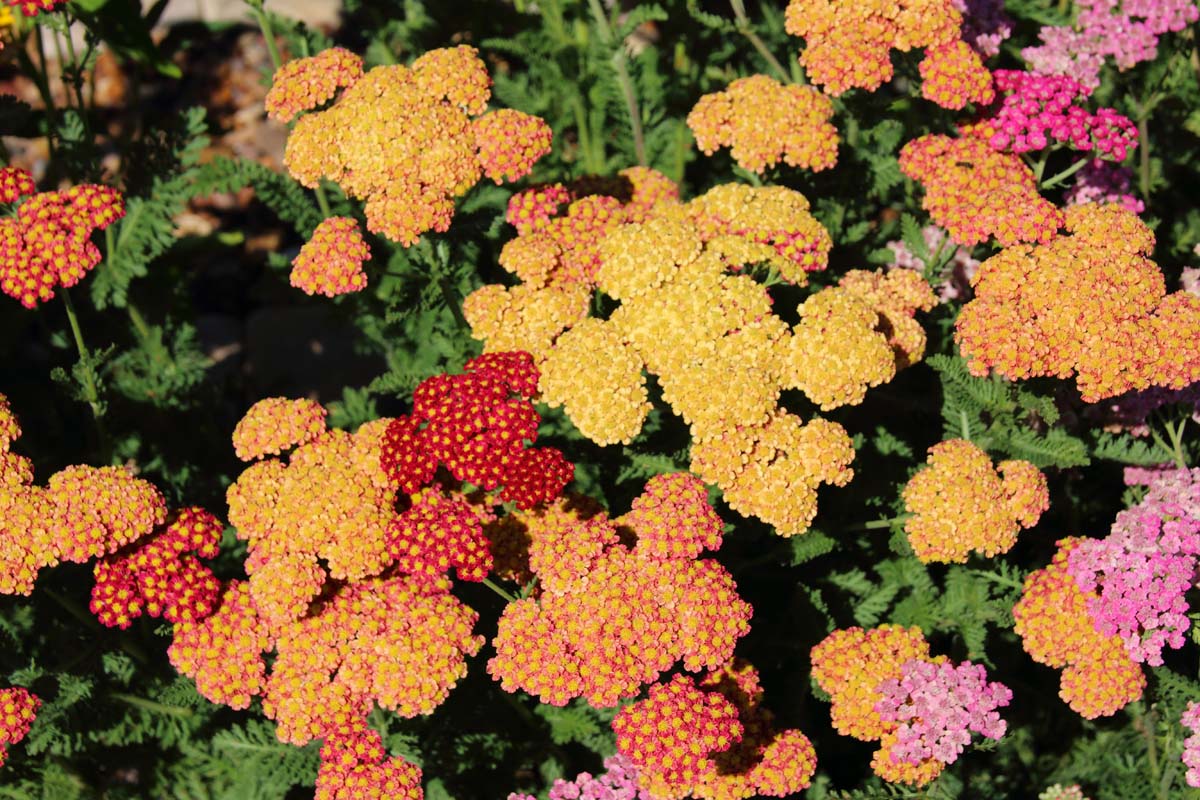
I have often shopped for yarrow at the end of summer, and picked up post-bloom cheap plants. I’ve bought rootbound pots in potluck colors and heights, and I’ve never been disappointed.
I just pop them into the ground as soon as I get home, and forget about them until they burst into bloom the following summer.
Anything that can thrive on neglect and produce stunning flowers deserves a place in the garden planner, don’t you think?
If you’re interested in growing more attractive flowers used as both culinary and medicinal herbs, you may enjoy the following:
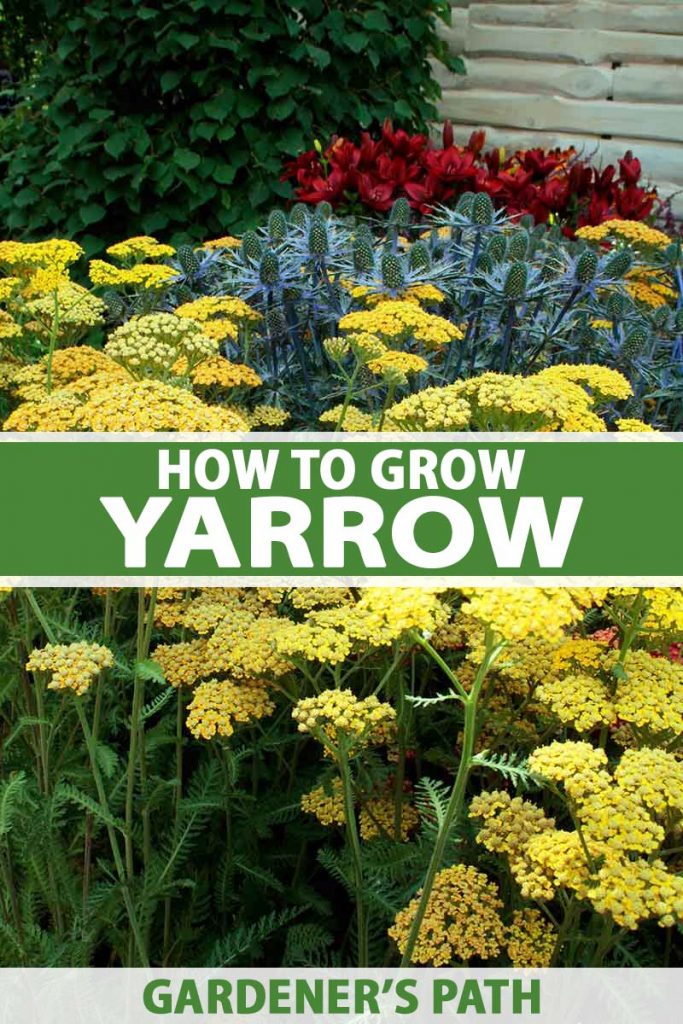
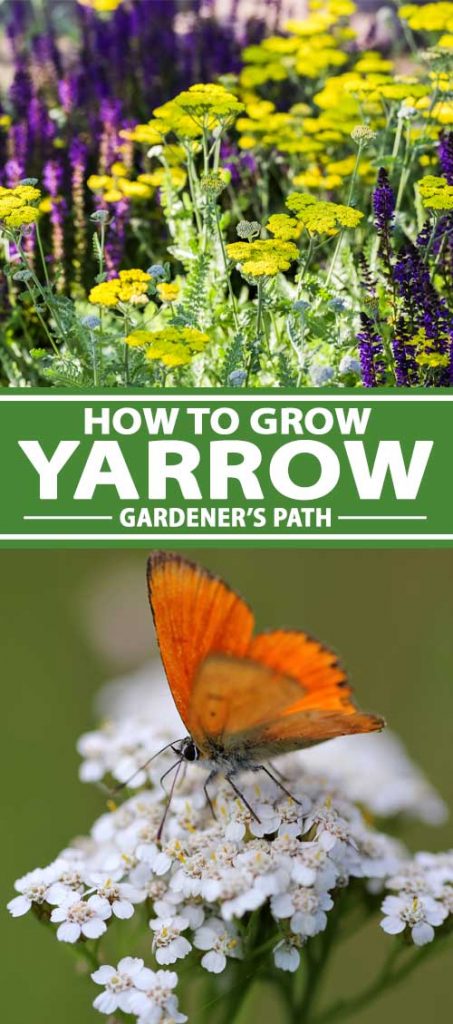
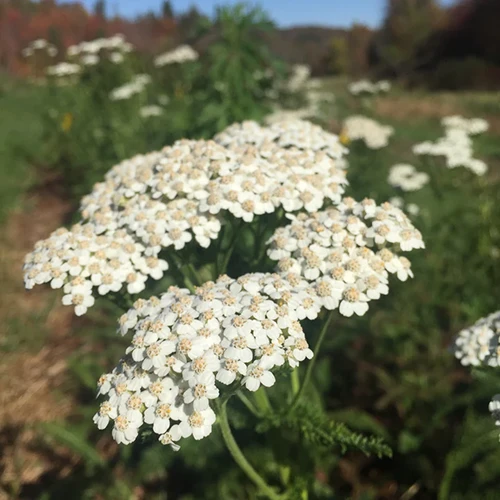
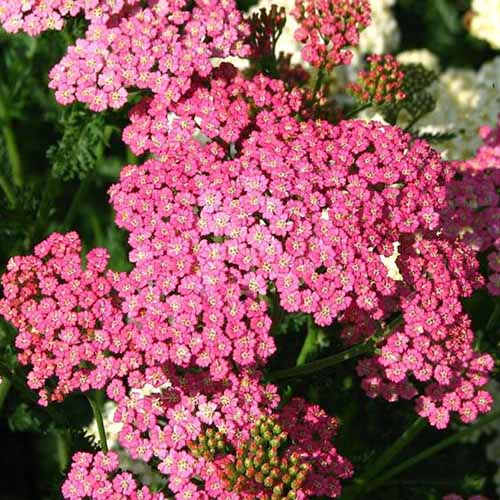
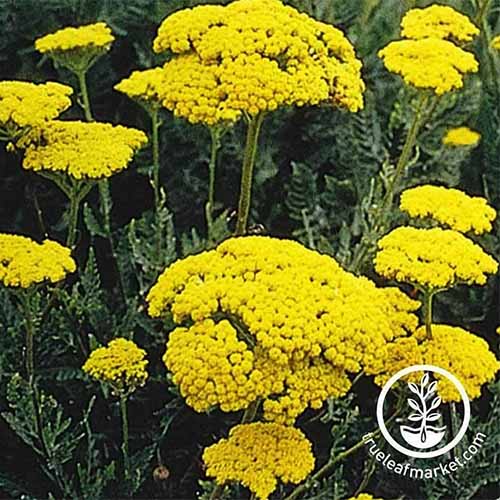

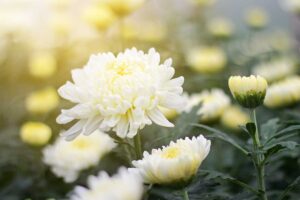
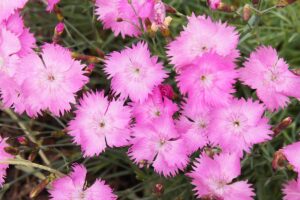
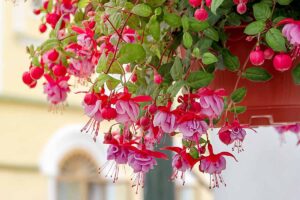
Hi Nan, I’m wondering if you know the variety of sea holly in the first photo paired with the yellow yarrow (wondering its variety as well). The blue and yellow are striking there, and I was looking for a companion plant for sea holly before I make the leap to put it there since they don’t relocate well. It’s the best idea I’ve seen YET! Thanks, Melanie
Hi Melanie – It’s Eryngium alpinum ‘Blue Star.’
Quick question – if I plant different colors of yarrow in the same spot will the dominant color overtake it?
Hi Henrietta –
Yarrow are prone to cross pollination. It is possible to start with several colors and end up one that dominates, especially with plants that are close to one another. Also, self-sowing may result in colorful hybrid plants producing seeds more like their white-hued forebears.
Hi Nan, I planted some “Moonshine” yarrow last year. At the time, I didn’t know yarrow prefers poor soil, so I mixed in some composted cow manure into the soil when planting. This year the plants look healthy (green leaves, getting bigger), but are producing few or no flowers. (I cut the old stems back in late winter). Why am I getting few or no flowers now? Is it the cow manure? Or do I just need to wait another year? PS-they are growing next to salvia that I planted at the same time, and the salvia are doing wonderfully.
Hi Jesse –
Cow manure contains nitrogen that can cause plants like salvia and yarrow to get leggy.
Yarrow and salvia prefer poor soil. The richness of cow manure is likely to produce many leaves and few flowers.
As the saliva isn’t planted directly in the cow manure, it is it performing as it should
At this point, I would just wait it out. Yarrow has a deep and broad root system and doesn’t often transplant well.
Be sure not to fertilize the yarrow, and don’t overwater it. With a little neglect, it may surprise you and improve.